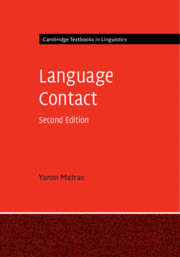
Language Contact
Sorozatcím: Cambridge Textbooks in Linguistics;
-
10% KEDVEZMÉNY?
- A kedvezmény csak az 'Értesítés a kedvenc témákról' hírlevelünk címzettjeinek rendeléseire érvényes.
- Kiadói listaár GBP 34.00
-
16 243 Ft (15 470 Ft + 5% áfa)
Az ár azért becsült, mert a rendelés pillanatában nem lehet pontosan tudni, hogy a beérkezéskor milyen lesz a forint árfolyama az adott termék eredeti devizájához képest. Ha a forint romlana, kissé többet, ha javulna, kissé kevesebbet kell majd fizetnie.
- Kedvezmény(ek) 10% (cc. 1 624 Ft off)
- Kedvezményes ár 14 619 Ft (13 923 Ft + 5% áfa)
Iratkozzon fel most és részesüljön kedvezőbb árainkból!
Feliratkozom
16 243 Ft

Beszerezhetőség
Becsült beszerzési idő: Várható beérkezés: 2026. január vége.
A Prosperónál jelenleg nincsen raktáron.
Why don't you give exact delivery time?
A beszerzés időigényét az eddigi tapasztalatokra alapozva adjuk meg. Azért becsült, mert a terméket külföldről hozzuk be, így a kiadó kiszolgálásának pillanatnyi gyorsaságától is függ. A megadottnál gyorsabb és lassabb szállítás is elképzelhető, de mindent megteszünk, hogy Ön a lehető leghamarabb jusson hozzá a termékhez.
A termék adatai:
- Kiadás sorszáma 2, Revised
- Kiadó Cambridge University Press
- Megjelenés dátuma 2020. szeptember 10.
- ISBN 9781108440080
- Kötéstípus Puhakötés
- Terjedelem426 oldal
- Méret 242x171x23 mm
- Súly 750 g
- Nyelv angol
- Illusztrációk 30 b/w illus. 104
Kategóriák
Rövid leírás:
Revised edition of a seminal introduction to language contact, providing an overview of the field and its most recent developments.
TöbbHosszú leírás:
Language contact occurs when speakers of different languages interact and their languages influence one another. Drawing on the author's own first-hand observations of child and adult bilingualism, this book combines his original research with an up-to-date introduction to key concepts, to provide a holistic, original theory of contact linguistics. Going beyond a descriptive outline of contact phenomena, it introduces a theory of contact-induced language change, linking structural change to motivations in discourse and language processing. Since the first edition was published, the field has rapidly grown, and this fully revised edition covers all of the most recent developments, making it an invaluable resource for researchers and advanced students in linguistics.
TöbbTartalomjegyzék:
1. Introduction; 2. An emerging multilingual repertoire; 3. Societal multilingualism; 4. Acquiring and maintaining a bilingual repertoire; 5. Crossing the boundaries: codeswitching in conversation; 6. The replication of linguistic 'matter'; 7. Lexical borrowing; 8. Grammatical and phonological borrowing; 9. Converging structures: pattern replication; 10. Contact languages; 11. Outlook.
Több



